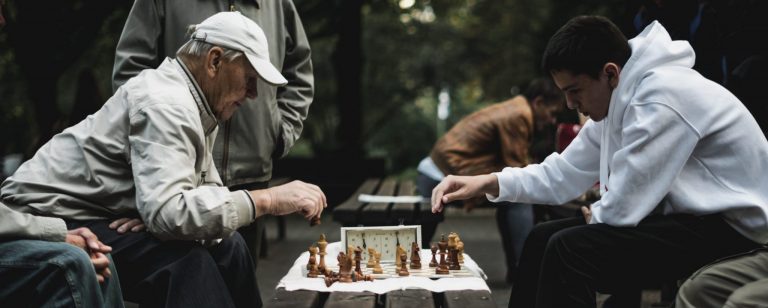Navigating the system that is American High Education – How Laddering Up requires decoding.
Mr. Montana Butsch
Dr. Travis Dorsch
To live and strive in America is a Hustle – the past decade has made this abundantly clear. The Varsity Blues Scandal just underscores the lengths to which some people are willing to go to address that very fact.
Varsity Blues was exposed on March 12, when federal prosecutors made public the worst case of admissions fraud in the history of higher education. In all, 50 people were indicted on charges that centered around individuals and families bribing coaches and admissions officers to get children into some of the nation’s elite institutions (the University of Southern California, Georgetown, Stanford, Texas, UCLA, Wake Forest and Yale). In a number of cases, students were admitted as recruited athletes despite the fact that they were not athletes, as falsely described in their admissions materials.
Why this is not surprising
As former recruited athletes to the Ivy League and Big Ten, respectively, our experience, history, and overall cynicism had us neither surprised nor shocked by the Varsity Blues scandal. The brazenness of the perpetrators is audacious but the entire story is one borne of a rotten system that has been hiding in plain sight for generations. Through a lot of hard work, a little luck, and serendipity of opportunity, we both gained access to elite universities as a result of our athletic endeavors[1]. In both cases, we likely would not have gotten into top-tier universities had it not been for our athletic abilities and the access that provided during the admission process. During our respective collegiate experiences, we came face-to-face with larger peer groups that held a very different understanding of societal norms than we did. Indeed, the support, opportunity, and perks that come along with being a college student-athlete is not the “reality” most students experience. We were therefore able to (forced to?) gain deep insight into the varied machinations of wealth and class in America – at least as presented by these Ivy League and Big Ten institutions.
In the years that have passed, our life pathways have been the direct result of a) the insight we were afforded by being part of a “club” (intercollegiate athletics) that granted us access, b) our personal histories (Montana is an inner city kid from Chicago and Travis is a small town kid from the Rocky Mountains), and c) our personal passion to help others through socially related enterprises. In reflection, all of our pursuits since we left Upenn and Purdue have, in some meaningful way, been affected by our decisions (and opportunity!) to enroll at such esteemed institutions. We were fortunate to become members of two separate but parallel clubs that created access and opportunity — access and opportunity we both take advantage of to this day. It is this type of esoteric access – and the potential future ramifications it can provide – that are the source of frustration felt by the masses when Operation Varsity Blues hit the news earlier this spring. But first let’s explore the context of the current situation.
The backdrop of the farce that is the Varsity Blues Scandal: the American Exceptionalism concept of Meritocracy
The key to creating fairness with opportunity is the concept of meritocracy. Built on the idea of fairness, equity, and the protestant work ethic, credence was given to societies dreams. The idea of meritocracy gave America a fantastic Public Relations angle. Hell, it made America the go-to destination for immigrants and migrants of all races and from all corners of the world. But it wasn’t entirely ever real. Additionally, in the continual quest to ladder up and maintain, hoarding opportunities quickly became the main goal of the majority of citizens. It is here, in the context of laddering up, that the Varsity Blues stunning reveal has its origin story.
In short, laddering up is hard. Individuals who have access get opportunities. Those opportunities lead to more access, and then to more opportunities. It is circular. For instance, when quality primary and secondary educational opportunities are seen as scarce goods, some parents employ strategies that will significantly increase their children’s likelihood of admission to the prized schools, even at the expense of other children. These children, when they become parents, are then willing – and, more importantly, capable – of doing the same for their own children. Such is the beginning of the cycle that screams opportunity hoarding and affords and restricts access to jobs, goods, relationships, prestige, and money. In a sense, our (perhaps unattainable) goal of “The American Dream” may end up reproducing rather than disrupting patterns of uneven access to education for historically under-served students.
It is easy to blame parents for spending five and even six figures on coaches, tutors, psychologists, consultants, and mentors for their children. However, doing so ignores many of the structural flaws in the system we ourselves have set up, most easily seen through the many policies in place that afford and incentivize such behaviors. It is no wonder that the arena of higher education has seen increasing calls for a comprehensive overhaul of its’ system.
America as seen in the mirror
Perhaps the most striking lesson from the recent scandal is that it has become very clear that our ideals for opportunity in America do not match what is actually happening. America has long been built on – and held up as a worldwide example of – the premise that hard work and dedication yield results that far outweigh the toil. It is a great narrative and laudable in its goals. However, it is more evident than ever that the starting point of an individual’s personal journey is anything but level and fair. And you don’t need to look too hard to identify the historical contradictions in the American system. Take your pick: in a country predicated by the machinations of capitalism, we have witnessed:
● Corporations being given the same rights as human beings
● The plight of disenfranchised Native Americans
● America’s capitalistic foundation supported by slavery
● Manipulation of the labor markets to support the industrial revolution, and
● Massive equal rights abuses against women, minorities, and ethnicities
The entire system was built upon a series of targeted inequality measures – it is only now that the methods employed are so nuanced and ingrained that they all become rather difficult to unwind and thoughtfully address.
Higher Education Duality. All about the “Benjamins” or a noble good?
Higher education’s history began as a way to nurture the perpetuation of wealth among the elite classes. The numbers were low. Formalized activities, internships, and advanced degrees in the traditional sense did not exist. At the beginning of the 20th century, only 2 percent of the college-age population between the ages of 18 and 24 attended a college or a university. It was only after WWII and the GI Bill that that number rose to 15 percent. Our modern day situation is a result of enrollment quadrupling between then and 1970 to a current modern day percentage over 60%. The advent of a credentialed driven society had begun. Over the course of generations, knowledge – and therefore wealth and access – grew in size, complexity, and reach. The current iteration of American higher education has over 10 million undergraduates enrolled in more than 2,500 four-year colleges and universities. The majority of these students attend schools that accept more than half their applicants (80%), roughly 3% attend universities that accept at a rate below 25%, and less than 1% attend a university that accepts at a rate below 10% (a rate typical of a highly selective institution)[i].
College in America has largely been based upon a competing duality of capitalistic tenets (institutions need to be financially solvent and demonstrate an ability to generate income) and a public good (they strive to enhance knowledge and practice in an effort to solve the problems of tomorrow today). These two values can co-exist; however, the relationship is tenuous. In other countries, this dialectic does not exist anywhere near to the same extent. Our system is, in short, wholly American.
The capitalistic pressures and incentives on boards of directors, presidents, and chancellors is real. The American market’s appetite for entertainment has driven the influence of money in college sports and the fact that universities play a key role in R&D for the country all conspire to muddy the educational waters. Add to this backdrop the coddling of the elite with alternate admission norms and practices and you have a witch’s brew of conflicting masters that ultimately create a very uneven playing field. A system ripe for manipulation.
To be sure, the corruption exposed by federal authorities in the Varsity Blues scandal was not pervasive. Indeed, only seven of the more than 1200 NCAA institutions were implicated. Importantly, many institutions across the NCAA’s Divisions I, II, and III have since taken internal steps to help ensure against another similar scandal. Nonetheless, Varsity Blues has rocked post-secondary education in the United States. It is a reality that has shaken the higher education to its core, in the same way the financial meltdown of 2008 changed the way Americans think about the stock, banking, and housing markets today. “It was a crack that was taken advantage of and needs to be addressed,” said Bernadette McGlade, the Atlantic 10 conference commissioner, in a New York Times story on May 9th. In short, it is now our duty to define, create, and ultimately pursue the higher education landscape to which we want to belong.
Why do we care?
In taking a step back, we see that the harm done by the college admission scandal is not limited to the young adults who were ensnared. It erodes the credibility of the entire process of obtaining access via fraudulent pathways. As the indictments roll in, we are also now beginning to see the impact the scandal will have on college coaches and administrators, as well as the parents of the students, all of whom are alleged to have conspired to circumvent traditional college admissions pathways in pursuit of money on one hand and a straighter path to admission on the other. While where someone goes to college might not seem like a life changing event, it carries the potential to greatly impact the individual’s life trajectory. In the educational world, it is widely understood that the earlier someone engages in experiences the quicker they master skill sets to be successful later in life. This all sounds obvious. But the mindfulness needed to constantly make these forward-thinking decisions is often lost on those that might benefit the most. While at one end it could mean ending up in the 5% upper income ‘salary’ bracket rather than the 10% (a difference of $40,000 – a 42% increase in salary based wealth) while at the other it could mean a move from the bottom 10% of the income distribution to the median (a jump from $5,000 to $30,000 – a 600% increase in salary based wealth)![i]
So how should this reality be navigated?
Education reform and transparency sound nice in theory, but in practice we don’t execute well. Ideas around an admissions lottery / matching system have been bandied about, but the current incentive structures for all involved parties will not allow for anything this progressive or radical. Rather, the best way to address this situation is to learn what game is actually played – while understanding what your current role within that game is. In basic language, before you engage you better know the rules of engagement. If sports offer better access to colleges and universities, which sports are best and how do colleges rank them? If STEM fields provide the best statistical chance at high earnings later in life, how can teens get on track to train up and gain interests to pursue? If personal networks are going to offer secret keys of access, what are their access points and how can they be infiltrated. Answering these questions leads necessarily to three important rhetorical questions: (1) Do these approaches leave people without “access” out of the higher education game altogether? (2) Are there purposefully built “invisible” barriers to entry that institutions and/or group norms support that make progress in these domains difficult? (3) What is the role – If any – of morality and ethics in the higher education process vis-à-vis the access to opportunities it provides to the American capitalistic environment? Perhaps the path forward is not premeditated retaliation against the injustices of an inappropriate system, but rather a tactful approach to run an end-around by proactively making decisions that target weak points in the rigged system. Maybe only then, with a fully gamed ecosystem, will the rules of the game reset and a more equitable allocation of opportunities and outcomes begin to coexist.
A way forward: addressing information asymmetry
Indeed, the college admission scandal is a situation of our own doing. We live in a system where there are always angles to play. Therefore, there will always be bad actors. Why is this the case? Who’s making the decisions? Largely and historically it has been white, educated, affluent males who are already part of “the club.” Said differently, bad actors and nefarious decision-making are just a result of the system that was set up ages ago to support a status quo and is only just being perpetuated in interesting and creative ways. Indeed, the system was built to be rigged and the hustle to take advantage is only afforded to those that understand this – and, thanks to the myth of meritocracy, our legal system has really only paid lip service to keep bad actors at bay.
We care because education is often the only game in town for folks who are looking to improve their life by laddering up in society. If the game remains rigged, cynicism will run rampant and society will suffer. In order to make higher-order decisions, information asymmetry is at the heart of this issue and it permeates the entire state of affairs. Rather than be contrarian and swim upstream like a salmon, the savvy consumers must be smart and tactful and decisive with their decision making.
About Authors:
Montana Butsch
Founder of spotivity, a dynamic and interactive search, mapping, and education app that helps enable users (kids and/or parents) make the best decisions about how to use time outside of school hours. The goal of spotivity is to maximize out of school time for both the targeted 13-17 user and provide support to the programs looking to increase growth and improve engagement. spotivity removes key logistical barriers to entry and promotes positive networking opportunities for all. This self-sustainable dynamic app will ultimately evolve into a lifestyle/social tool and grow in importance as the user ages. Prior to spotivity, Montana was the founder and CEO of major sports non-profit organization which has served thousands of inner-city children in Chicago and who has formed extensive ties with Chicago business, philanthropy and government leaders.
Travis Dorsch
Associate Professor and Founding Director of the Families in Sport Lab in the Department of Human Development and Family Studies at Utah State University. Travis teaches undergraduate courses in lifespan development and human motivation and graduate courses in human development and quantitative and qualitative research methods. Having documented the impact of children’s youth sport participation on parents and families while pursuing his doctoral studies at Purdue University, his current research includes a complementary focus on the role of youth sport participation on family relationships and family interaction, evidence-based parent education in youth, adolescent, and early adult settings, and the role of internal factors (e.g., motivation) and external factors (e.g., families and social contexts) on sport, physical activity, and recreational behavior. Prior to his role as a professor, Travis was a former NFL Kicker for both the Cincinnati Bengals and Green Bay Packers.
[i] USA Education Department Data Center AND Ms. Alia Wong (The Atlantic)
[i] http://wallethacks.com/average-median-income-in-america/
[1] Montana joined the rowing team in high school (the only team in the state of Illinois at that time) and ultimately landed a coveted place at the University of Pennsylvania. Travis was a multisport athlete who excelled at football and baseball, earning a number of scholarships from prestigious programs across the country, ultimately settling on Purdue University







